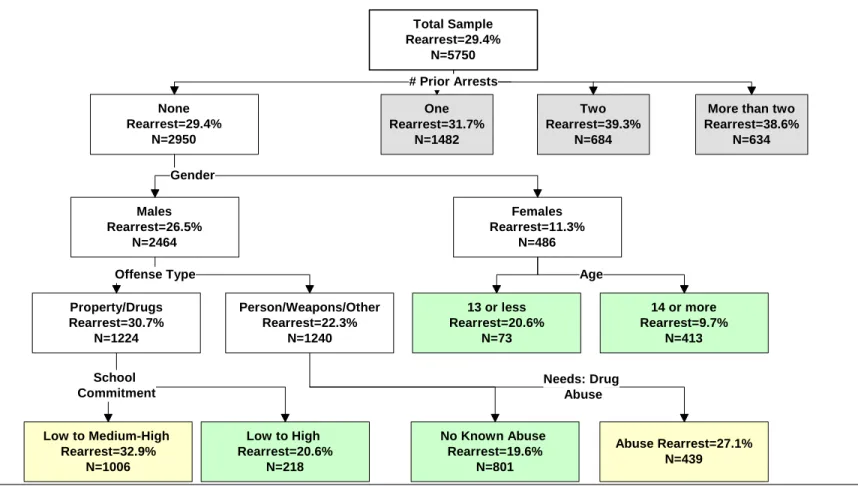PREDICTIVE RISK
MODELING AND DATA
MINING
Child Protective Services Modeling: 3 Counties in
New York State
•
OCFS identified substantiated (and recidivism for cases with prior investigations), and unsubstantiated investigations
as target outcomes for the modeling team. Recidivism (or reentry) was selected because it is one OCFS’s CFSR
Program Improvement Plan outcomes.
•
Our sample consisted of 55,934 cases of child maltreatment reported to the NYS hotline between 2001-2010
where cases were defined as either having no substantiated dispositions (76.5% of all cases) or at least one
substantiated disposition (23.5% of all cases).
•
Results: The team tested several predictive models, ultimately developing strong models for predicting
substantiated/recidivism cases (91% accuracy) and unsubstantiated cases (almost 90% accuracy).
•
One of the most surprising findings was the differences between counties, making county a significant and high
ranking variable for predicting substantiation/recidivism.
•
In the next phase of the project the team will utilize statewide data, introduce advanced nonlinear data mining
algorithms to optimize the models, and develop a live shadow system for testing and analysis.
Step 1: PCA/Factor Analysis Ranks 44
Significant Measures
1 MANDATED_IND_1
2 REPORT_AGE_NBR_1
3 COUNTY_COUNTY_NM_1
4 VICTIM_INTAKE_AGE_NBR_1
5 NCANDS_REPORTER_CD_1
6 N_INTAKES
7 VICTIM_ETHNIC_CD
8 SUBJECT_ETHNIC_CD_1
9 PRIORS
10 SUBJECT_INTAKE_AGE_NBR_1
11 ALLEGATION_TXT_1
12 ALLEGATION_CD_1
13 N_CLOSES
14 VIC_RECS
15 SUBJECT_HISP_LATINO_IND_1
16 SUBJECT_SEX_CD_1
17 ALLEGATION_GROUP_TXT_1
18 PERP_RECS
19 VICTIM_SEX_CD
20 INQTR_1
21 INMONTH_1
22 VICTIM_HISP_LATINO_IND
23 INDAY_1
3
Step 2: Several Different Algorithms Were Tested
Initial analysis of the overall sample dataset:
9998 total randomly selected cases, 44 features (Final predictors)
Unfounded Cases:
The best prediction model is strong (almost 90% accurate) at finding
cases not substantiated within our predefined low range
Total records in range: 4404.
Actual records with a known value of 0 = 3926 cases. That shows 89% accuracy.
Indicated Cases:
The best prediction model is good (70% accurate) at finding cases
substantiated within our predefined high range. Less than 25% of the total sample had a
substantiated outcome.
Total records in range: 195.
Actual records with a known value of 1 = 138 cases. That shows 70% accuracy.
Our next step was to include Safety Factor data into the model
5
Caretaker previously committed or allowed others to abuse or maltreat child Caretaker’s current alcohol abuseseriously affects his/her ability to care for child Caretaker’s current drug abuseseriously affects his/her ability to care for child
Child has or is likely to experience physical or psychological harm due to domestic violence
Caretaker’s mental illness/developmental disabilityimpairs ability to supervise, protect or care for child Caretaker is violent and appears out of control
Caretaker is unable/unwilling to meet child’s basic needs for food, clothing, shelter and/or medical care Caretaker is unwilling/unable to provide adequate supervision of child
Caretaker caused serious physical harm to child or has made a plausible threat of serious
Caretaker views/describes/acts negatively toward child and/or has extremely unrealistic expectations of child Child’s whereabouts are unknown, or the family is about to flee or refuse access to the child
Caretaker caused serious physical harm to child or has make a plausible threat of serious harm
Caretaker views/describes/acts negatively toward child and/or has extremely unrealistic expectations of child Child’s whereabouts are unknown, or the family is about to flee or refuse access to the child
Current allegation or history of sexual abuse and caretaker is unable/unwilling to adequately protect child Physical living conditions are hazardous
Child is afraid of or extremely uncomfortable around people living in or frequenting the home Child has Positive Toxicology for drugs and/or alcohol
Child is on sleep apnea monitor
Weaponnoted in CPS report or found in the home Other/criminal activity (specify):
Several Models Reach 87-91% Accuracy Predicting Substantiation and Recidivism Using
New Safety Factors Data
Juvenile Recidivism PRM with Integrated
Data in Philadelphia
NCCD’s Wisconsin SDM Risk Instrument... carefully
developed, validated, widely used.
Configural Analysis.. customized risk assessment tool.
Neural Networks.. more sophisticated customized analysis..
the future?
Utilize single data source.
Integrated Data Source
Database of 40,000+ cases.
All dispositions from Family Court where more than regular
probation (program or state).
Different data sources – court records, DHS staff assessments,
self report.
Current sample 8,239 cases, dispositions with staff/self-report
CHAID Model: Outline
Total Sample Rearrest=29.4% N=5750 None Rearrest=29.4% N=2950 One Rearrest=31.7% N=1482 Two Rearrest=39.3% N=684 Females Rearrest=11.3% N=486 Males Rearrest=26.5% N=2464 Person/Weapons/Other Rearrest=22.3% N=1240Figure 2.1 Dendogram of Predictors of Re-Arrest (1 Prior exploded)
Low to Medium-High Rearrest=32.9% N=1006 Low to High Rearrest=20.6% N=218 13 or less Rearrest=20.6% N=73 Property/Drugs Rearrest=30.7% N=1224 14 or more Rearrest=9.7% N=413 Age Offense Type School Commitment Gender No Known Abuse Rearrest=19.6% N=801 Abuse Rearrest=27.1% N=439 Needs: Drug Abuse
More than two Rearrest=38.6%
N=634 # Prior Arrests
